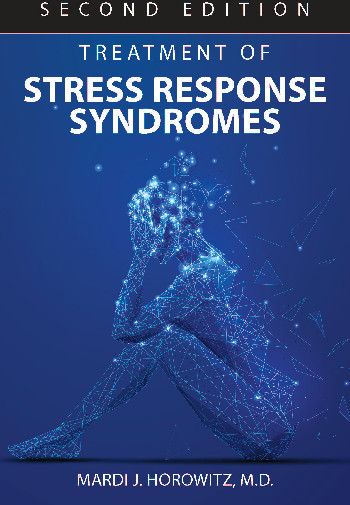By Mardi J. Horowitz, M.D.; Washington, D.C., American Psychiatric Association Publishing, 2021, 108 pages
Galileo Galilei once said, “All truths are easy to understand once they are discovered; the point is to discover them.” In Treatment of Stress Response Syndromes, Second Edition, by Mardi J. Horowitz, the author uncovers many truths that some therapists have never been exposed to. This is so because psychotherapy for trauma patients has often been limited to manual-driven brief psychotherapies. Horowitz challenges these limitations.
Dr. Horowitz, a true pioneer in the field of traumatic stress, offers a second edition of his previously published book. I read the first edition, and it is obvious that a significant amount of work went into this update. I propose that the second edition has a triple function: an initiation for the beginning trauma therapist, a guide for psychiatric residents, and a quick reference for the seasoned clinician in a trauma program or the U.S. Department of Veterans Affairs. Horowitz masterfully weaves in cases, case vignettes, and detailed theoretical explanations of the latest neurophysiology of trauma. This is beyond what many monographs offer.
Among the book’s highlights, chapter 1, “Principles of Psychological Responses to Stressor Events,” comprises a preamble for clinicians who embark on a journey in psychotherapy with trauma patients, which discusses the possible pitfalls of brief therapy imposed by parameters of external circumstances. Traumatic grief is presented as an integral part of traumatic disorders. I found the introduction of tables and psychotherapy algorithms to be balanced and user friendly. (This is an important point, because many current texts on therapeutics rely excessively on tables.) Chapter 2, “Assessment and Treatment Planning,” explores a significant question, all too well known by trauma therapists: When do we cover traumatic events and how? The treatment of Bill, a case vignette, is a telling clinical journey that operates as a how-to guide for real-world situations. The chapter’s essential presentation of complex posttraumatic stress disorder (PTSD) and its impact on identity and personality is a highlight for any beginning trauma therapist (
1). Complex PTSD, a condition that is little understood by many American clinicians, is currently included in the
ICD-10 but not the
DSM-5.
Chapter 4, “Linking the Meanings of Stressor Events to the Self,” includes a clarification for the novice therapist regarding memories of trauma. How is it that the mental “snapshot” of the trauma reemerges in the form of reexperiencing, emotions, dissociation, etc.? The therapist must navigate the experience of trauma by carefully walking a line between overmodulation or undermodulation of the emotional experience. Consequently, a patient’s autobiography of the trauma may eventually shift from a paradigm narrowly focused on trauma and PTSD toward a broader real-world exposé of human experience. Here, Dr. Horowitz gives a clinical example of prolonged grief, or traumatic grief, a condition still underresearched but extremely important in understanding the cumulative effect of trauma. In the same chapter, Dr. Horowitz solves another hurdle in trauma treatment: the complicated relationship between adjustment disorders and PTSD. This chapter provoked the question, For a person who has experienced traumatic loss, how many times do we mistakenly diagnose an adjustment disorder, and what are the consequences? Personality has a major role in over- or undermodulation of emotions, and thus, in the delay of coping.
Referring to previous studies, Horowitz notes that the most common obstacles to tolerating the emotions of feelings (and, I would add, in forming of new, curative narratives) are excessively inhibiting ideas about distressing emotional topics (69%), excessively switching back and forth between attitudes to avoid emotions (64%), and unrealistic distortion of reality to preserve narcissistic self-investing and avoid deflation of self-esteem (41%) (
2). This finding could be easily extended to most of the resistance encountered with any psychotherapy patient.
Decision trees and tables add significant value to this text by enhancing the exploration of how to approach patients at different critical crossroads when therapy has been entangled and ceases to progress. Examinations of patients’ defensive styles (e.g., avoiding information that deflates self-esteem, dislocating bad attributes from self to another, forgiving oneself too easily when remorse is justified) are well articulated in concise rules worthy to include in any psychotherapy training.
One needs to understand a plethora of other topics to become a seasoned trauma therapist. Chapter 6, “Renarration and Reschematization,” which discusses language as the most reliable form of communication for sharing clarity and covers the implicit models of “self” and “other” and their reference to personality function, reminded me of my own work that has promoted the rebuilding of the implicit self as part of healing (
3). The author describes how stylistic variation in posture and gestures can be recognized in therapy and can be useful in the process of renarration and reschematization. Chapter 7, “Terminating,” extensively covers termination of therapy, and chapter 8, “Assessing Change,” includes a useful review of all available rating scales relevant to trauma.
Of note is the author’s addition in the preface regarding the COVID-19 pandemic and its relevance to the text. He posits that during the pandemic, individuals may need help in three areas: heightened demand of self-care and family and community support; concerns about preexisting psychiatric disorders and prospective exacerbations of symptoms, leading to immobilization and suicidality; and triggering of stress response syndromes related to the COVID-19 pandemic and the failing economy.
I found it particularly inspiring that Dr. Horowitz’s new edition of Treatment of Stress Response Syndromes is being released at a time when his counsel on this subject has become, historically, most relevant.


